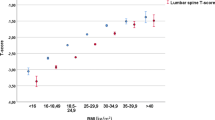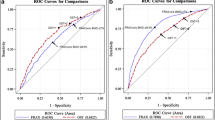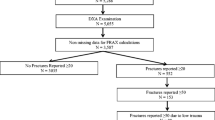Abstract:
Elderly women with very low bone mineral density (BMD) (T-score ≤−3.5) have a risk of hip fracture more than two times higher than the average risk of women of the same age. Using data from the EPIDOS prospective study, we have shown that by measuring BMD on the 50% of women who have the lowest weight, it is possible to identify the majority of these women at higher risk. In the present analysis, we assessed whether the use of clinical risk factors, in the subset of women selected for osteodensitometry and with moderately low BMD (T-score between −3.5 and −2.5), allows the identification of another subgroup of women with a risk 2 times higher than average and, thereby, increases the efficiency of selective BMD screening. We then assessed the discriminant value for hip fracture of the overall screening strategy (i.e., use of weight to select women for osteodensitometry, then use of clinical risk factors to enhance the predictive value of BMD), and compared it with the value of BMD used as a population screening tool. In total, 6933 EPIDOS participants, aged 75 years or above, were included in this analysis. Using Cox regression models, we first determined which baseline factors were most predictive of hip fracture among the 1588 women with weight below median (selection criteria for osteodensitometry in the proposed strategy) and T-score between −3.5 and −2.5. Based on the relative risk (RR) estimates from the final risk function, we calculated an individual risk score for hip fracture. We assessed the incidence of hip fracture for each value of the score, and determined the cutoff to identify women with a risk about 2 times higher than the average risk in this elderly cohort. The overall screening strategy (i.e., selective BMD measurement based on weight, followed by clinical fracture risk assessment) identifies two subgroups of higher risk women: a group with very low BMD (T-score ≤–3.5), and another group with moderately low BMD (T-score between –3.5 and –2.5) but a high fracture risk score. We calculated the total number of women classified as being at high risk, and assessed the overall sensitivity and specificity of this strategy to identify elderly women who will suffer a hip fracture. Among women with weight below median and T-score between −3.5 and −2.5, the factors most predictive of the risk of hip fracture were age, history of fall, ability to do the tandem walk (test of dynamic balance), gait speed and visual acuity. A simple additive score based on these factors (except visual acuity) allows a high-risk group (risk about 2 times higher than average) to be clearly distinguished from a low-risk group (risk below average). Overall, the proposed strategy identifies approximately 15% of the women in the cohort as being at high risk, i.e., 543 women with T-score ≤−3.5 and 503 women with −3.5 <T-score ≤−2.5 and a high fracture risk score. The sensitivity for hip fracture is equal to 37% and the specificity to 85%, which is equivalent to the discriminant value of BMD as a population screening tool. In elderly women, the use of a simple clinical risk score, in women with previous BMD values, allows the number of high-risk women identified to be increased. Overall, the proposed screening strategy (use of weight to select women for osteodensitometry, and then use of clinical risk factors to enhance the predictive value of BMD) has the same discriminant value for hip fracture as BMD used as a population screening tool.
Similar content being viewed by others
Author information
Authors and Affiliations
Additional information
Received: 20 November 2001 / Accepted: 11 February 2002
Rights and permissions
About this article
Cite this article
Dargent-Molina, P., Douchin, M., Cormier, C. et al. Use of Clinical Risk Factors in Elderly Women with Low Bone Mineral Density to Identify Women at Higher Risk of Hip Fracture: The EPIDOS Prospective Study . Osteoporos Int 13, 593–599 (2002). https://doi.org/10.1007/s001980200078
Published:
Issue Date:
DOI: https://doi.org/10.1007/s001980200078




